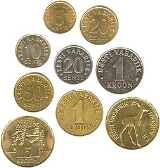
Estonian kroon
Encyclopedia
In 1992, coins were introduced (some dated 1991) in denominations of 5, 10, 20 & 50 senti, as well as 1 kroon. The 1 kroon was struck in cupronickel
, the others in aluminum-bronze. However, in 1997, nickel-plated steel 20 senti were introduced, followed by aluminum-bronze 1 kroon in 1998. 5 senti coins were not issued after 1994 but were still legal tender. The cupronickel 1 kroon coins from 1992, 1993 & 1995 stopped being legal tender on 31 May 1998. The 5 krooni coins were commemorative pieces and were rarely seen in circulation.
Coins in circulation before being replaced by the euro:
{|class="wikitable" style="font-size: 90%"{|
!rowspan="2"| Image
!rowspan="2"|Nominal value
!colspan="4"| Technical parameters
|-
!Diameter
!Weight
!Edge
!Composition
|-
|
|5 senti
|15.95 mm
|1.29 g
|rowspan="4"| plain
|rowspan="4"| copper 93%, aluminum 5%, nickel 2%
|-
|
|10 senti
|17.20 mm
|1.87 g
|-
|
|20 senti
|18.95 mm
|2.27 g
|-
|
|50 senti
|19.50 mm
|3 g
|-
|
|1 kroon
|23.25 mm
|5 g
|rowspan="2"|jagged
|rowspan="2"| copper 89%, aluminum 5%, zinc 5% Sn 1%
|-
|
|5 krooni
|26.20 mm
|7.1 g
|}
Cupronickel
Cupronickel or copper-nickel or "cupernickel" is an alloy of copper that contains nickel and strengthening elements, such as iron and manganese. Cupronickel is highly resistant to corrosion in seawater, because its electrode potential is adjusted to be neutral with regard to seawater...
, the others in aluminum-bronze. However, in 1997, nickel-plated steel 20 senti were introduced, followed by aluminum-bronze 1 kroon in 1998. 5 senti coins were not issued after 1994 but were still legal tender. The cupronickel 1 kroon coins from 1992, 1993 & 1995 stopped being legal tender on 31 May 1998. The 5 krooni coins were commemorative pieces and were rarely seen in circulation.
Coins in circulation before being replaced by the euro:
- 5 senti (1991, 1992, 1995)
- 10 senti (1991, 1992, 1994, 1996, 1997, 1998, 2002, 2006, 2008)
- 20 senti (1992, 1996, 1997, 1999, 2003, 2004, 2006, 2008)
- 50 senti (1992, 2004, 2006, 2007)
- 1 kroon (1992, 1993, 1995, 1998, 2000, 2001, 2003, 2006, 2008)
- 5 krooni (1993, 1994).
{|class="wikitable" style="font-size: 90%"{|
!rowspan="2"| Image
!rowspan="2"|Nominal value
!colspan="4"| Technical parameters
|-
!Diameter
!Weight
!Edge
!Composition
|-
|
|5 senti
|15.95 mm
|1.29 g
|rowspan="4"| plain
|rowspan="4"| copper 93%, aluminum 5%, nickel 2%
|-
|
|10 senti
|17.20 mm
|1.87 g
|-
|
|20 senti
|18.95 mm
|2.27 g
|-
|
|50 senti
|19.50 mm
|3 g
|-
|
|1 kroon
|23.25 mm
|5 g
|rowspan="2"|jagged
|rowspan="2"| copper 89%, aluminum 5%, zinc 5% Sn 1%
|-
|
|5 krooni
|26.20 mm
|7.1 g
|}
See also
- Currency boardCurrency boardA currency board is a monetary authority which is required to maintain a fixed exchange rate with a foreign currency. This policy objective requires the conventional objectives of a central bank to be subordinated to the exchange rate target....
- Economy of EstoniaEconomy of EstoniaEstonia is a member of the European Union and the eurozone and is an advanced economy, according to the IMF.Before the Second World War Estonia's economy was based on agriculture, but there was a significant knowledge sector and a growing industrial sector, similar to Finland...
- Estonian euro coinsEstonian euro coinsEstonian euro coins feature a single design for all eight coins. This is a design by Lembit Lõhmus and features a silhouette map of Estonia together with the word Eesti and twelve stars, symbolic of the European Union, surrounding the map...
- Estonian markEstonian markThe mark was the currency of Estonia between 1918 and 1928. It was initially equivalent to the German Papiermark, which had been circulating alongside the Russian/Soviet ruble since the German occupation. It was divided into 100 penni...

